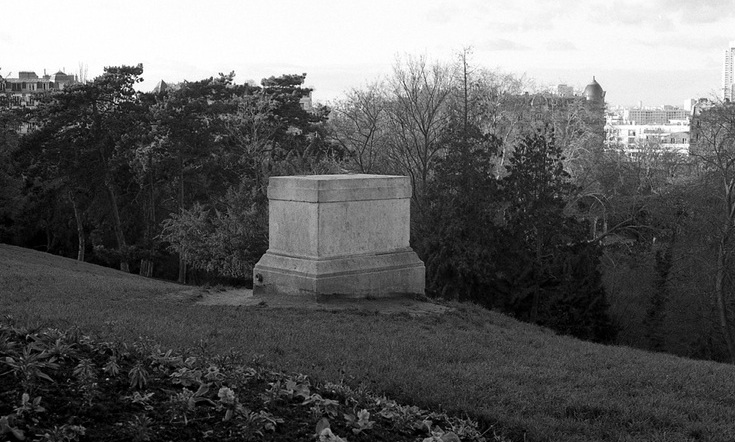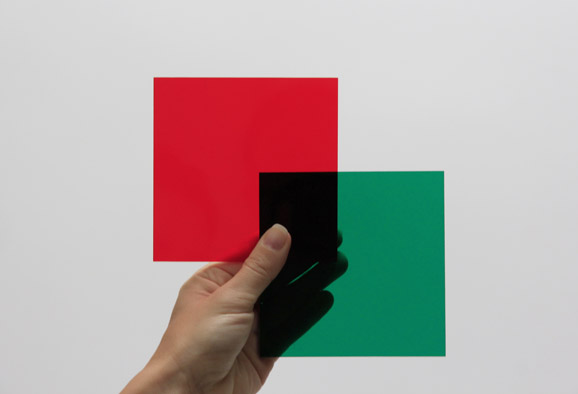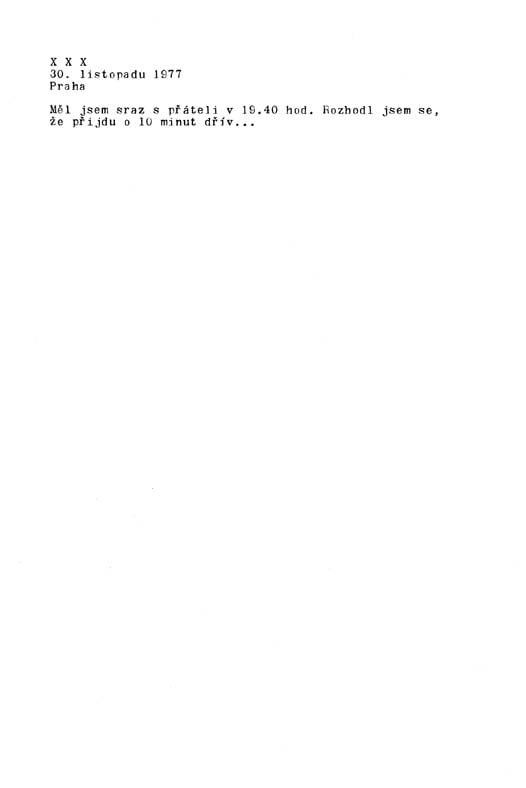
© » KADIST
Jiri Kovanda
Drawing & Print (Drawing & Print)
All Kovanda’s artistic practice poses the question of visibility. Having worked on actions and performance, the artist decided to ‘disappear’ from his artworks during twenty years; in 2007, his performance Kissing through glass in the institutional setting of Tate Modern was acclaimed by critics. Some works are only visible thirty years later via traces and archives; the artist’s rehabilitation by institutions and galleries offers a new critical reading of his practice which had until then remained rather confidential.
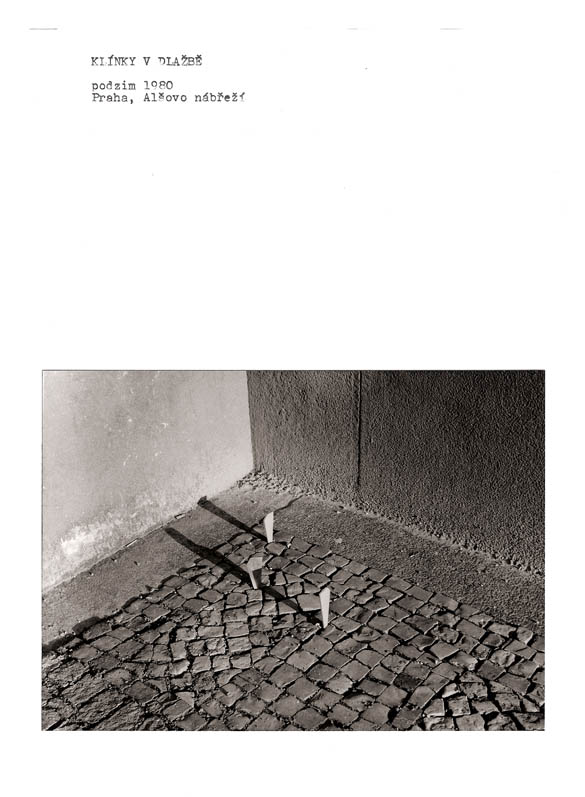
© » KADIST
Jiri Kovanda
Kovanda’s street interventions are always documented according to the same format as the actions: a piece of A4 paper, a typewritten text giving a precise location and date, and a photograph. Contrarily to the actions, he took the photographs himself. One of the rules he stuck to in his artistic practice was to always use material at his disposal, a real economy of means.
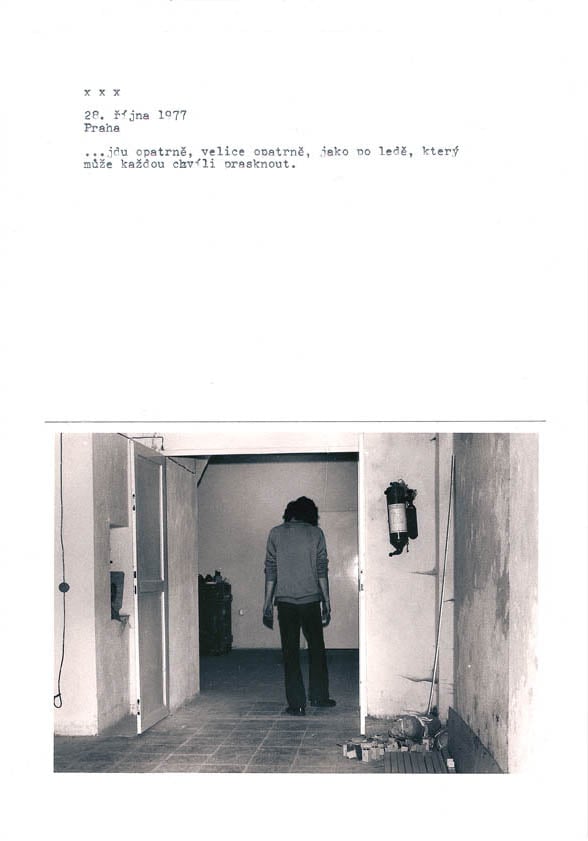
© » KADIST
Jiri Kovanda
Kovanda’s ‘discreet’ actions (leaving a discussion in a rush, bumping into passers-by in the street, making a pile of rubbish and scattering it, looking at the sun until tears come…) are always documented according to the same format: a piece of A4 paper, a concise typewritten text, and sometimes a photograph taken by someone else. This action, walking abnormally slowly, questions the place of the individual within the space of a city with regards to social habits. Kovanda places himself slightly outside the regulated rhythm of the city walking.

© » KADIST
Jiri Kovanda
This ephemeral installation by Jirí Kovanda, documented in the same way as his performances with a photograph and a text, belongs to a body of works that took place in his apartment/studio. During an interview with Hans Ulrich Obrist, the artist highlighted that he had never had a studio and that this work space blended with his apartment. A piece of string cuts across the room in a diagonal; it functions as a scale to measure time and space.

© » KADIST
Jiri Kovanda
Kovanda’s street interventions are always documented according to the same format as the actions: a piece of A4 paper, a typewritten text giving a precise location and date, and a photograph. Contrarily to the actions, he took the photographs himself. One of the rules he stuck to in his artistic practice was to always use material at his disposal, a real economy of means.

© » KADIST
Jiri Kovanda
Kovanda’s street interventions are always documented according to the same format as the actions: a piece of A4 paper, a typewritten text giving a precise location and date, and a photograph. Contrarily to the actions, he took the photographs himself. One of the rules he stuck to in his artistic practice was to always use material at his disposal, a real economy of means.

© » KADIST
Jiri Kovanda
Untitled (1992) responds to the same principles of an economy of means as the artist’s actions and installations: three empty cardboard boxes which have contained photographic film are piled one on top of the other. Nevertheless there is a harmony in the assembly of forms, writing, colors, proportions; an aesthetic construction is carried by this contemporary still life. This work charts the passing of time: the cardboard yellows, the film becomes obsolete in the digital age.
Jiri Kovanda
- location: Praha, Ceská Republika
- year born: 1953
- gender: male
- nationality: Czech

© » SLASH PARIS
about 28 months ago (05/04/2023)
L’œil vérité — Le musée au second degré — MAC VAL Musée d'art contemporain du Val-de-Marne — Exhibition — Slash Paris Login Newsletter Twitter Facebook L’œil vérité — Le musée au second degré — MAC VAL Musée d'art contemporain du Val-de-Marne — Exhibition — Slash Paris English Français Home Events Artists Venues Magazine Videos Back L’œil vérité — Le musée au second degré Exhibition Mixed media Upcoming Roman Cieslewicz, M...

© » SLASH PARIS
about 28 months ago (05/04/2023)
L’œil vérité — Le musée au second degré — MAC VAL Musée d'art contemporain du Val-de-Marne — Exposition — Slash Paris Connexion Newsletter Twitter Facebook L’œil vérité — Le musée au second degré — MAC VAL Musée d'art contemporain du Val-de-Marne — Exposition — Slash Paris Français English Accueil Événements Artistes Lieux Magazine Vidéos Retour L’œil vérité — Le musée au second degré Exposition Techniques mixtes À venir Roman Cieslewicz, M...

© » LARRY'S LIST
about 35 months ago (10/05/2022)
Meda Mládková, Leading Czech Collector Whose Passion for Art Ran Deep, Dies at 102 - via ARTnews...
-
1970-1979
Jiri Kovanda
Drawing & Print
1977(Drawing & Print) All Kovanda’s artistic practice poses the question of visibility...
Jiri Kovanda
1979This ephemeral installation by Jirí Kovanda, documented in the same way as his performances with a photograph and a text, belongs to a body of works that took place in his apartment/studio...
-
1980-1989
Jiri Kovanda
1980Kovanda’s street interventions are always documented according to the same format as the actions: a piece of A4 paper, a typewritten text giving a precise location and date, and a photograph...
Jiri Kovanda
1980Kovanda’s street interventions are always documented according to the same format as the actions: a piece of A4 paper, a typewritten text giving a precise location and date, and a photograph...
Jiri Kovanda
1980Kovanda’s street interventions are always documented according to the same format as the actions: a piece of A4 paper, a typewritten text giving a precise location and date, and a photograph...
-
1990-1999
Jiri Kovanda
1992Untitled (1992) responds to the same principles of an economy of means as the artist’s actions and installations: three empty cardboard boxes which have contained photographic film are piled one on top of the other...
